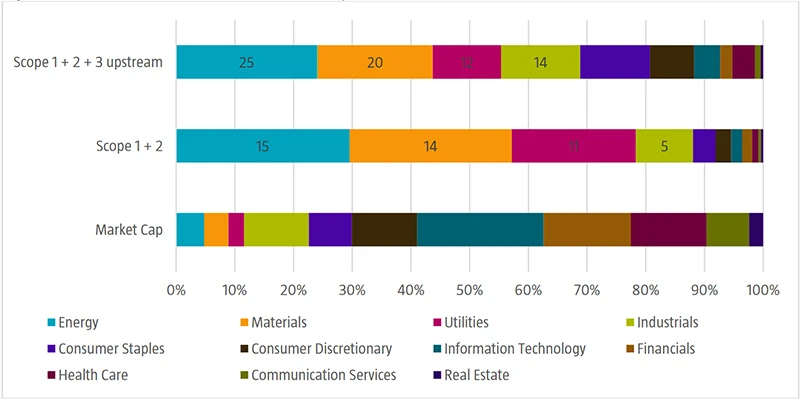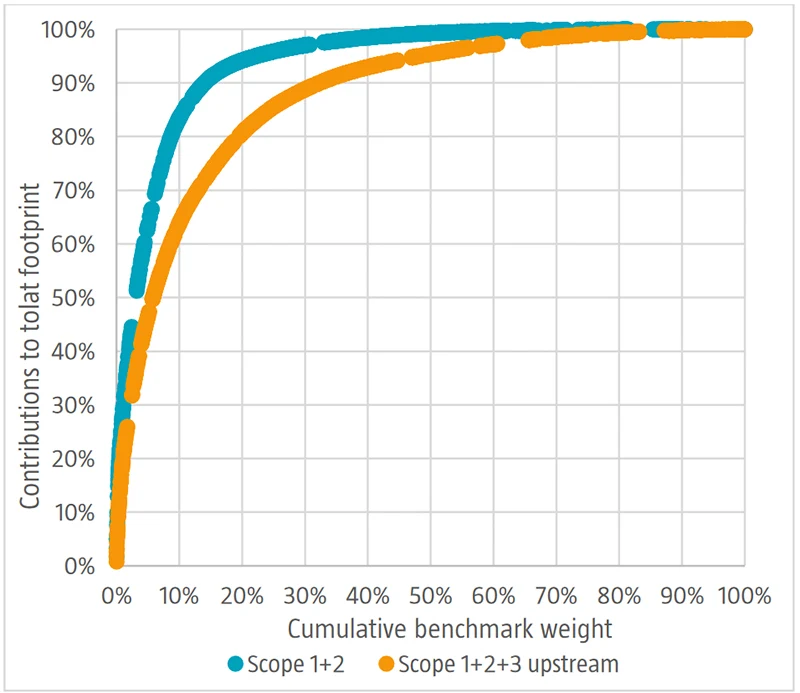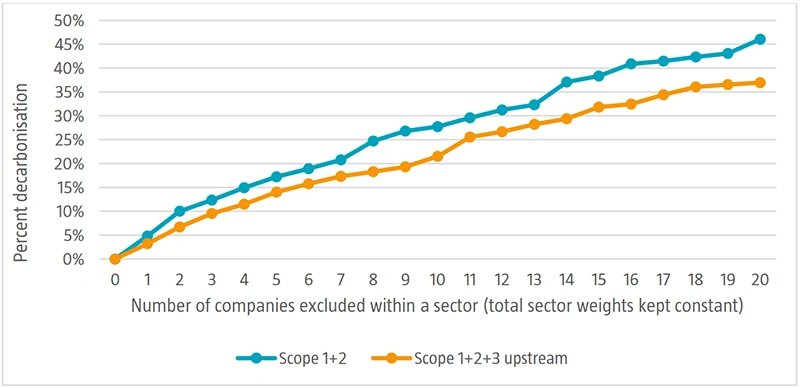As a reminder, Scope 1 emissions are those generated by the company and Scope 2 are produced by the energy needed to make the product or provide the service. Scope 3 is generated across the entire value chain, and is much more difficult to quantify. Scope 3 can be split into two parts: upstream, which includes the emissions of suppliers, and downstream, which focuses on the end-user.
The majority of asset managers, including Robeco, have so far set interim emission reduction targets for Scope 1 and 2. We believe that including Scope 3 upstream is a necessary next step in order to capture the emissions along the full value chain.
As we start to consider integrating Scope 3 upstream into our emission reduction targets, we look at the impact this may have on our portfolios and how this can be managed. We first consider the impacts on sectoral distribution of emissions. We then evaluate changes in the concentration of those emissions. We conclude with the impact this could have on portfolios seeking to meet specific emission-reduction targets.
Impacts on sectoral distribution of emissions
When adding Scope 3 upstream data, some sectors gain relative importance compared to using Scope 1 and 2 only, whereas for other sectors the relative importance decreases.
This is illustrated in Figure 1. Energy, Materials and Utilities account for almost 80% of the MSCI World footprint when only Scope 1 and 2 are considered, despite the market cap of these sectors being just over 10% of the index. Adding Scope 3 upstream would decrease the contribution of these sectors to around 55% of the total footprint.
Other sectors then become relatively more important. For instance, Industrials, Consumer Discretionary and Consumer Staples are jointly responsible for one third of the MSCI footprint when Scope 3 upstream is included, compared to merely 8% when considering only Scope 1 and 2. Other sectors like Information Technology and
Health Care have also substantially increased their contribution, although this is less visible due to their relatively smaller overall contribution.
We believe that the carbon footprint distribution including Scope 3 upstream better represents emissions from the global value chain than when only using Scope 1 and 2. It shifts the attention from focusing only on the supply side of the fossil fuel value chain to also incorporating the demand side which indirectly contributes to 23% of global emissions.
Figure 1 | Sectoral contribution to the carbon footprint of the MSCI World Index²

Source: MSCI World, S&P Trucost, Robeco
Concentration of emissions is lower when Scope 3 upstream is included
The high concentration of Scope 1 and 2 emissions across a small number of emitters has so far made portfolio decarbonization somewhat easier. Therefore, we need to see whether portfolio decarbonization will become significantly harder to achieve when Scope 3 upstream is included.
Figure 2 shows the results of this analysis. We have first sorted the companies from high to low footprints. The horizontal axis shows the cumulative weight of the sorted companies, and the vertical axis the cumulative footprint contributions. For instance, 20% of the MSCI World market cap contributes 95% to the footprint using Scope 1 and 2. This means that significant reductions in portfolio footprints can be achieved by limiting the weight of only a small proportion of companies.
However, once Scope 3 upstream is included, the highest emitting 20% of market cap is responsible for 80% of the footprint. This indicates that the concentration of emissions is lower, requiring more significant portfolio changes in order to meet significant decarbonization targets. This is also consistent with our view that when seeking to achieve real-world decarbonization, we cannot only focus on a handful of companies. Every company has a role to play, particularly when it comes to influencing the demand for fossil fuels.
The more emissions are distributed amongst companies, the harder decarbonization becomes. This has implications for funds which have tight tracking error budgets against a traditional benchmark in the case where the real world economy does not follow the required decarbonization pathway.
Figure 2 | Cumulative footprint contributions and weights for the MSCI World

Source: S&P Trucost, Robeco.
The portfolio impact of incorporating Scope 3 upstream
The broader sector distribution and the lower presence of outliers impacts the ability to decarbonize a portfolio and has an influence on the best approach to use to do so. This section investigates these issues by considering both sector allocation and security selection as approaches to decarbonizing a portfolio.
Starting with sector allocation, we examine how much decarbonization can be achieved by allocating less to certain sectors. Specifically, we look at the percentage change in the total index footprint from underweighting a sector by a percentage point. This 1-point weight is then proportionally distributed across the other sectors. Figure 3 shows these results.
Figure 3 | Allocation effects when integrating Scope 3 upstream

Source: Trucost, Robeco.
When considering only Scope 1 and 2, decarbonization can be relatively easily achieved by underweighting any of the Utilities, Materials and Energy sectors. Underweighting any other sector would result in an increase in the footprint. When Scope 3 upstream is included, we see smaller decarbonization opportunities from those three sectors. This can make decarbonization against a benchmark more difficult, as overall value chain emissions are distributed more evenly over the different sectors. Underweighting Consumer Staples and Industrials can also contribute to decarbonization when Scope 3 upstream is included, albeit only marginally.
As portfolio decarbonization becomes more difficult from a sector allocation perspective, the decarbonization from security selection within a given sector could become more important. Figure 4 gives an insight into how the footprint changes when removing the largest polluters within each sector, while keeping the overall sector weights constant. Thus, the weights of the removed companies get proportionally distributed over the other companies within that sector.
Figure 4 | Selection effects when integrating Scope 3 upstream

Source: S&P Trucost, Robeco.
For instance, if we remove the two most polluting companies from each sector, we see a 10% decarbonization using Scope 1 and 2, while if Scope 3 upstream is integrated, this reduces to 7%. When we consider more companies, the absolute difference between the lines slightly increases, but in both cases, we still see the benefit from excluding more heavy polluters. In line with the allocation analysis above, we see that although portfolio decarbonization becomes more challenging when Scope 3 upstream is integrated, there still is enough room for substantial improvements in the carbon footprint of portfolios.
Taking the next step: Integrating Scope 3 upstream in our interim reduction targets
While portfolio decarbonization may become more challenging, we feel it is necessary to integrate Scope 3 upstream into our interim reduction targets in order to ensure we are capturing emissions across the value chain, and we would like to see the industry standard move this way. As well as the portfolio implications laid out above, this has practical implications, such as recalculating the baseline used for our targets, updating prospectuses and commitments.
While this article has focused on portfolio decarbonization (Pillar I of our net zero roadmap3) our eye still remains focused on the ultimate goal, which is real world decarbonization. We believe the inclusion of Scope 3 upstream in our targets will help with this, but will also continue to tackle this through Pillars II and III of our roadmap, specifically through accelerating the transition through engagement and by promoting climate-aligned investing.
With regards to Scope 3 downstream, significant issues remain, and more research needs to be conducted. Indeed, Paris Aligned Benchmarks which mandate Scope 3 integration have faced some challenges due to poor data quality and the backward-looking nature of emissions.4
One solution in the meantime is to already use forward-looking analytics, such as our proprietary Paris Alignment Assessment (Robeco Traffic Light) and our climate impact metric (Robeco Climate Score) to factor in some of the risks and impacts posed by holding a position with poorly managed, material Scope 3 downstream emissions.
We hope that this three-article mini-series has shed some light on the issues with Scope 3, solutions to address these issues and implications for future portfolio construction. We look forward to more industry guidance on this topic and will remain engaged with the research in this field
Footnotes
1IPCC AR6 Working Group 3 Figure 2.12 (Climate Change 2022: Mitigation of Climate Change [ipcc.ch])
2Carbon footprint refers to absolute emissions divided by enterprise value including cash (EVIC)
3https://www.robeco.com/files/docm/docu-robeco-roadmap-to-net-zero.pdf
4https://www.ipe.com/asset-class-reports/equities-rethinking-net-zero-benchmarks/10068584.article


